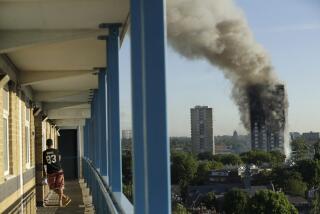Cause of Building Accident Sought; 3 Bodies Removed
- Share via
Government investigators Thursday began trying to pinpoint the cause of the partial collapse of a high-rise building under construction in downtown Los Angeles, as workers completed the tricky and dangerous job of sifting through rubble to remove the bodies of the three ironworkers who died in Wednesday’s accident.
The victims were Edward Leon Winchester, 47, of the Los Angeles area; Michael James Golden, 29, of Upland, and his brother, Patrick Duane Golden, 28, of Ontario.
“They were extremely close,” a tearful, emotion-choked Kimberly Golden, Michael’s widow, said of the brothers. “They worked (on the same jobs) whenever they could.”
Michael Golden left two sons, ages 6 and 4, she said. Patrick Golden left a 2-year-old son and a pregnant wife, Dianne. Winchester was a crew foreman.
Of six men injured in the accident, only Kenneth McKellar, 27, who suffered a broken neck, remained hospitalized.
Investigators from three government agencies--the state Occupational Safety and Health Administration (Cal-OSHA), the Los Angeles Police Department and the county district attorney’s office--were at the scene of the collapse during the day, checking reports that too many steel I-beams had been stacked on the structure’s fifth floor, or had been improperly stacked, causing a rupture of the sheet-metal underflooring, which sent girders tumbling and the men plunging to their deaths.
Authorities were also checking for any design flaws in the 21-story office tower under construction at 1000 Wilshire Blvd. and for any possibility that the deaths were the result of some sort of gross negligence that could be construed as a crime.
“Our investigation will take considerable time,” said Deputy Dist. Atty. Kenneth Wullschleger, a prosecutor in the office’s occupational safety and health section.
Gordon Ostby, district manager of the Vernon office of Cal-OSHA, said his investigators will probably not have their final report done for at least a month. He said they are trying to resolve conflicting accounts of how many of the girders were stacked and how much they weighed when the flooring gave way.
An undetermined number of the girders had been hoisted by crane from a flatbed truck below to the fifth-floor level, where ironworkers stacked them for use in erecting the sixth-floor frame. Eyewitnesses said the flooring collapsed just as the ironworkers disengaged a girder from a guy, or steadying, wire.
Ostby said he has heard varying reports that each truckload of girders weighed anywhere from two tons to 22 1/2 tons.
“There’s a good possibility that the load was more than the supports could carry . . . but it’s not confirmed,” he said. “It’s possible the bolts (holding together the assembled I-beams) were insufficient. Maybe they left bolts out. Maybe it should have been welded and bolted and wasn’t.”
Russell Lane, the city’s principal building inspector for major downtown structures, said he went to the fifth floor after the tragedy.
“(I saw) a considerable amount--10 or more beams--still there,” he said. “What they were doing (stacking beams) was common, other than the overloading.”
An inspector from the city Building and Safety Department was at the site virtually daily, Lane said. “In fact, he was there a half-hour before this happened.”
Lane said it appeared that bolts holding together secondary floor-support beams had done their jobs. He said it was possible that the beams had not been stacked directly atop floor-support beams, but instead had been stacked on the corrugated metal underflooring, which sits atop the support beams. This could have put too much weight on the underflooring. He also said the crane might have struck the underflooring and that could have weakened it. And he said the crane might simply have dropped a beam too hard.
Bodies of the dead were recovered from the building’s sixth subbasement. Ironworkers used torches and a crane to cut and lift away the metal beams and flooring that blocked access to their colleagues’ bodies, which were within about 10 feet of one another.
Even after workers had removed some wreckage, Los Angeles Deputy Fire Chief Don Dahlstein said the area was still dangerous.
“You have some of the large beams that are being supported by a matter of only a couple of inches (on another beam),” he said. “It wouldn’t take too much stress or movement and you could have another accident.”
City building inspectors said they would not permit construction to resume until engineers assure them that it is safe.
The building is being constructed by Reliance Development Group Inc. Swinerton and Walberg Construction Co. are the general contractors, and James F. Beasley and Co. of Dallas and Long Beach is the subcontractor in charge of erecting the girders.
Times staff writer Jerry Belcher also contributed to this article.
More to Read
Sign up for Essential California
The most important California stories and recommendations in your inbox every morning.
You may occasionally receive promotional content from the Los Angeles Times.













